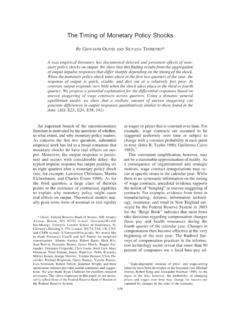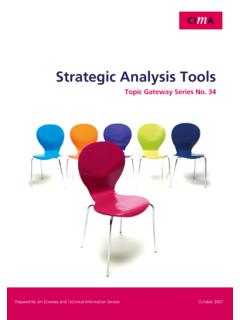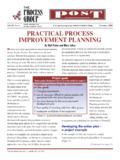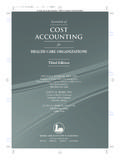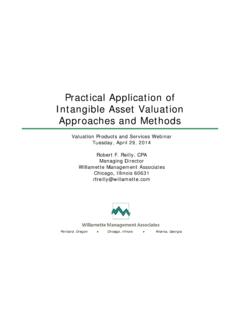Transcription of THE THEORY OF COST-BENEFIT ANALYSIS
1 Chapter 14 THE THEORY OF COST-BENEFIT ANALYSISJEAN DREZE AND NICHOLAS STERN *London School of Economics1. Basic IntroductionCost-benefit ANALYSIS is very widely used and it is therefore important that itsmethods be properly understood. In this chapter we try to contribute to theunderstanding by giving a formal description of the subject and examining thetheoretical basis for some of the techniques which have become accepted tools ofdecision-making around the purpose of COST-BENEFIT ANALYSIS is to provide a consistent procedure forevaluating decisions in terms of their consequences. This might appear as anobvious and sensible way to proceed, but it is by no means the only one(examples of alternative procedures are majority voting, collective bargaining, theexercise of power, or the assertion of rights).
2 So described, COST-BENEFIT analysisclearly embraces an enormous field. To keep our subject-matter manageable, weconfine most of our attention in this chapter to its best-known and mostimportant application: the evaluation of public sector projects. Nevertheless, the*The chapter was written at different places in the period 1982-85 including the Indian StatisticalInstitute and the Development Economics Research Centre (DERC) at the University of support was received from the Economic and Social Research Council through the DERCand the programme "Taxation, Incentives and the Distribution of Income" at the London School have benefited greatly from the comments and suggestions of E. Ahmad, Arrow, , A. Auerbach, Bell, Bliss, Chetty, D. Coady, Deaton, Diamond, Diewert, Dixit, Dreze, Fields, R.
3 Guesnerie, Hammond, I. Heggie, C. Henry, Hughes, Ireton, Johansson, D. Lal, Little, M. Marchand, Newbery, Roberts, A. Sandmo, Scott, J. Seade, Sen, Smith, S. Venu, and Bibliographical assistance was provided in the summer of 1982 by Graham Andrew to whomwe are very grateful. All errors are of Public Economics, vol. II, edited by Auerbach and M. Feldstein 1987, Elsevier Science Publishers B. V. (North-Holland) THEORY we develop also offers clear guidelines for the evaluation of governmentdecisions in such varied fields as tax, trade or incomes policies, the provision ofpublic goods, the distribution of rationed commodities, or the licensing of shall concentrate on THEORY . Furthermore, we shall not attempt to present asurvey or summary of the vast literature on the theoretical aspects of the , we shall put forward a view of how COST-BENEFIT ANALYSIS should proceed,give a fairly unified account of the most salient results of the theoreticalliterature, show how the framework encompasses a number of approaches to thedefinition and formulation of COST-BENEFIT problems, and then discuss implica-tions for a number of practical , the contents of the paper are as follows.
4 In Section 1 weintroduce the basic concepts of COST-BENEFIT ANALYSIS for project evaluation. Inparticular we show how and when shadow prices can be used to constructcost-benefit tests which evaluate projects in terms of their net effect on socialwelfare. For this to be the case, the shadow price of a commodity must be definedas the total impact on social welfare of a unit increase in the net supply of thatcommodity from the public sector. In order for this definition to be operational,it must be possible to predict all the repercussions of a project. We shall embodythis idea in the notion of a "policy" and emphasise the close relationship betweenshadow prices and the choice of policies. We attempt, in Section 2, to drawtogether some important results selected from the theoretical literature, byanalysing a single model and following the principles outlined in Section 1.
5 InSection 3 we review a number of more practical issues at the centre of theliterature on applied project evaluation (the treatment of traded and non-tradedgoods; the discount rate; the shadow wage, and so on) in the light of the previousresults. Section 4 contains concluding Project evaluation, COST-BENEFIT ANALYSIS , and shadow pricesIn this subsection we introduce some basic concepts which will be usedthroughout. They are given formal structure, discussed and developed in the restof the a project, we shall understand a change in the net supplies of commoditiesfrom the public sector. The term "public sector" is interpreted here in asomewhat restricted sense, which will be clarified below; however, the THEORY wedevelop also provides precise guidelines for the evaluation of projects in theprivate sector.
6 The ANALYSIS will be conducted from the point of view of aplanner, who has to assess projects and who has preferences over states of theeconomy, embodied in a well-defined objective function or "social welfare"910J. Drze and N. SternCh. 14: THEORY of COST-BENEFIT Analysisfunction. The interpretation, specification and necessity of the objective functionwill be discussed in detail process of judging whether or not a project should be accepted is calledproject evaluation. COST-BENEFIT ANALYSIS is the examination of a decision in termsof its consequences or costs and benefits . The shadow price of a good measuresthe net impact on social welfare of a unit increase in the supply of that good bythe public the context of project evaluation a COST-BENEFIT test is a simple decision rulewhich consists of accepting only those projects which make a positive profit atshadow prices.
7 As we show below, our definition of shadow prices ensures thatshadow profits are precisely a (first-order) measure of the net effect of aproject on social welfare, so that COST-BENEFIT tests succeed in identifying welfare-improving order to evaluate a project from the point of view of its consequences, it iscrucial to have a model which predicts the total effect on the state of the economyof undertaking a particular project. This total effect involves a comparison of theeconomy "with" the project and the economy "without" it. Formally, weembody the relation between a project and its consequences in the notion of a"policy", a rule which associates a state of the economy with each publicproduction plan. It is a recurring theme of this chapter that different policiescorrespond to different rules for shadow pricing.
8 To the extent that severalpolicies are genuinely available, we argue that the policy and project should beselected with respect to the same criterion, the level of social welfare. We alsoexamine closely the special case where there is no real choice and only one policyis available to the two basic ingredients of the approach to COST-BENEFIT ANALYSIS which isadopted in this chapter are therefore the ability to predict consequences (amodel) and the willingness to evaluate them (an objective function).A major purpose of using the techniques of COST-BENEFIT ANALYSIS , and particu-larly shadow prices, is to allow decisions at the level of the enterprise in thepublic sector. In principle one could imagine a planner who is endowed withinformation on the working of the entire economy and well informed aboutpossible projects, who could calculate the level of social welfare associated withany possible course of action.
9 Formally this is how most optimising modelsappear. We know, however, that it is generally impossible for one office or bureauto be fully acquainted with possibilities and difficulties at each enterprise andhousehold. Thus, we seek to leave many decisions at a level closer to theindividual enterprise but to provide information by which individual decisionsmay be co-ordinated. With this information each enterprise can take decisionswhilst exploiting its own detailed knowledge of its own circumstances. Thus, ourapproach does not assume full knowledge of production possibilities but is911simply concerned with providing information to public enterprises for the ap-praisal of their own The basic THEORY of shadow pricesWe develop in this subsection a model which formalises the concepts introducedabove.
10 It will be given further structure in Sections 2 and economy consists of "private agents" and a "planner". The THEORY as suchallows the identity of the planner to be interpreted in various ways, at oneextreme the planner could represent a powerful government agency controllingmany policy instruments, and at another it could designate a analyst solelyconcerned with the evaluation of a single project. For purposes of interpretation,we shall also speak of the planner as "the government", bearing in mind,however, that when governments are not "monolithic", all the agencies not underthe control of the planner should formally be included in the set of agents behave systematically, in response to a vector s = (sk) of signalssummarising all the relevant variables affecting their behaviour (prices, taxes,quantity constraints, etc.)

